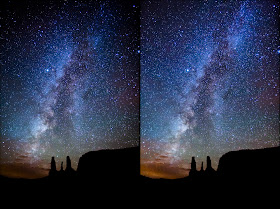 |
Unless you correct lens vignetting, your NightScape images will look like the left image.
Although the left image has more "drama", it is technically incorrect, & lacking in detail.
Milky Way over "Three Sisters" formation in Monument Valley ~ © Royce Bair |
Lens Vignetting: All camera lenses suffer from some light fall-off near the edges and corners of the images they project. This is known as lens vignetting. Vignetting is usually more pronounced when the lens is used "wide-open" or at it's widest aperture. Most of the vignetting goes away when the lens is stopped down by two or three aperture stops.
NightScape photography brings out the worst in lens vignetting because one is often forced to shoot wide open. This maximum light is needed to reduce shutter times (keeping star trailing to a minimum), and to lower ISO settings (keep down digital noise), which are already unusually high.
Adobe Camera Raw to the rescue. ACR's "Lens Corrections" feature can virtually eliminate lens vignetting problems. If you are using a major brand lens with electronic coupling to your camera body ACR will automatically pull up your lens' profile (using the image file's EXIF info) and make the needed vignetting corrections (and distortion corrections) when you check the "Enable Lens Profile Corrections" box! You can control the amount of these corrections using sliders. I typically allow the profile to make a full, 100% correction.
Using ACR is one of many reasons to shoot in camera RAW. ARC is available with both Adobe Photoshop and Adobe Lightroom.
Editor's Note: So many photographers ignore lens vignetting in astro-landscape photography, that the "darkened corner look" in starry night sky photos has become the norm. Besides, many would argue, "it adds a certain amount of drama and mystique" to the image (similar the the artificial vignetting photographers often add to a portrait, in order to draw more viewer attention to the person, and less to the background). Unfortunately, lens vignetting gives the viewer an unnatural look of the night sky, and eliminates a lot of valuable detail (stars and shadow detail in the landscape foreground). With proper lens vignetting correction, these details can be restored —then, if the photographer chooses, he/she can darken ("burn down") the areas he/she wants to add drama (or use to guide our attention), and still retain detail.
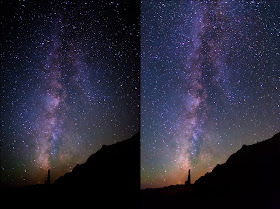 |
No lens vignetting correction on left image - ACR's "Lens Corrections" to right image
"Milky Way Paint Brush" - Kodachrome Basin State Park ~ © Royce Bair |
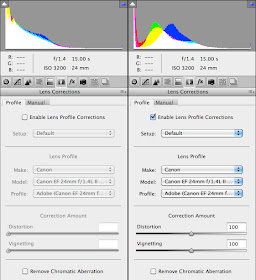 |
By checking the "Enable Lens Profile Corrections", ARC's "Lens Corrections"
feature automatically applies vignetting and distortion corrections to your
Canon, Nikon and other major brand lenses. Note the change to the histogram. |
Correction with Non-Standard Lenses: When using a Nikkor lens (via an adapter) on a Canon body (or vice-versa), you will not have electronic coupling to feed EXIF info to your image file. If you are using a manual lens, i.e. a
Rokinon lens, you will also not have this information. In these cases, you'll have to manually look up your lens information. In the case of the Rokinon, there is no profile currently listed (as of ACR 7.0). In this situation, you will need to click on the Manual tab, and make your own vignetting adjustments (see below).
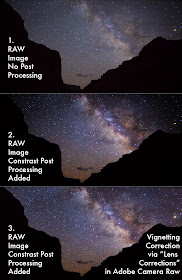 |
1. The Camera Raw file, using a Rokinon 24mm f/1.4 lens (wide open), shows some vignetting.
2. Vignetting becomes more pronounced when post processing contrast is added to image.
3. Most of the vignetting disappears when manual "Vignetting Correction" is applied (below). |
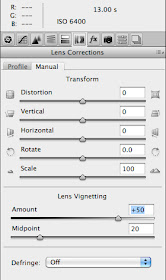 |
ACR's "Lens Corrections" in manual mode when using a manual lens, i.e. the Rokinon 24mm f/1.4
In most cases, I use a vignetting amount of about +50, then move the Midpoint to about "20". Each
lens is a little different —just move the sliders until your image corners match the density of the
rest of your image. The histogram (not shown) will also provide feedback. Note that the lens
info (focal length and f/stop) is not shown at the top because there is no electronic coupling.
|
Royce's 2014 Workshop, Lecture & Video Conference Schedule: NightScapeEvents.com
- 25% OFF savings on select "IMAGE10" workshops booked before April 1, 2014 -





Very helpful blog on vignetting. On my next night shoot I'll try your advice. Tommy.
ReplyDelete